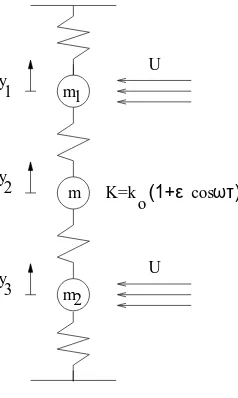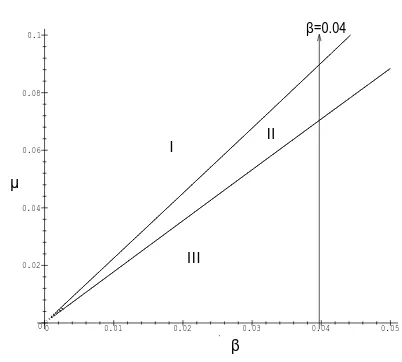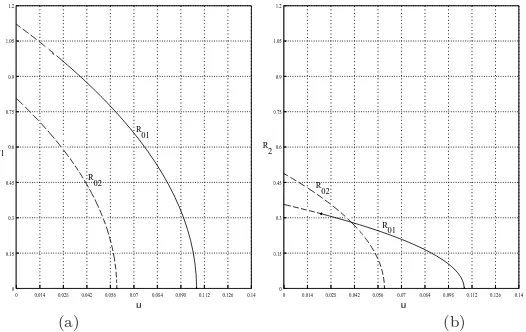PARAMETRIC EXCITATION
IN A SELF-EXCITED THREE-DEGREES
OF FREEDOM PROBLEM
SITI FATIMAH
Abstract. The effect of parametric excitation in self-excited has been investigated in
two-degrees of freedom problems. The possibility of suppressing self-excited vibrations by using parametric excitation and the dynamic behavior of those kind systems were discussed. In the this paper, we consider a system in three-degrees of freedom problem which by using a linear transformation the system becomes an Autoparametric. The system consists of a central mass and two external masses where those masses are conected by springs with the same constant stiffness. The flow-generated self-excited force is acting on the external masses, it is represented by Rayleigh force. The variable stiffness is periodically varying in time, represents a parametric excitation. It turns out that for certain parameter ranges full vibration cancellation is possible. The analysis of linear case of system shows that there are two conditions in order to obtain an interval of the parametric excitation. Using the averaging method the fully non-linear system is investigated producing as non-trivial solutions unstable periodic solutions. The behavior of this unstable solution is studied in the full system.
1. INTRODUCTION
Some slender structures, like tubes in heat exchangers or rods between two walls, are often self-excited by flow. In these cases, the self-excited vibration is an unfavorable phenomenon leading to an increased loading of structural elements. It is sometimes able to break down them. The system can be realized by a mechatronic device similar to magnetic bearings or by pneumatic springs with a variable inner pressure, see Tondl and Nabergoj [9]. There are several ways to limit the influence
Received 30-10-2009, Accepted 20-12-2009.
2000 Mathematics Subject Classification: 37C99
Key words and Phrases: Parametric Excitation, autoparametric, Three-degrees of freedom problems
The effect of parametric excitation has been investigated in a two-mass sys-tem, see Tondl [9], [14], [15] and Fatimah and Verhulst [2], [3]. In Ecker and Tondl [1], the conditions when full suppression of the vibration could be achieved, have been analytically studied. In Fatimah and Verhulst [3], the same system as in [1] is considered. The results show that, using the first-order approximation of the averaging method, full vibration cancellation is possible in an open parameter set. Using the second-order approximation, the minimum value of the response can be calculated if the secondary mass is small. It shows that a large amount of quench-ing is still possible. The results of the influence of the parametric excitation on the self-excitation in two-degrees of freedom system suggest to study its contribution in higher degree of freedom systems.
In this study we consider a three-degrees of freedom system governed by the following differential equations:
m1y¨1+k(2y1−y2)−bU2(1−γoy˙21) ˙y1= 0 (1)
my¨2+k(2y2−(y1+y3)) +ko(1 +εcosωt)y2+boy˙2= 0 (2)
m2y¨3+k(2y3−y2)−bU2(1−γ◦y˙23) ˙y3= 0. (3)
The simple model of this system is shown in the Figure 1. The model consists of a central mass and two external masses. The ends of the external masses are
elastically mounted by using springs of variable stiffness. The central mass m
and the external masses m1 and m2 represent reduced concentrated masses of
body elements while the connecting springs simulate their elasticity. The springs
have constant stiffness k. The flow-generated self-excited force is acting on the
external massesm1andm2; it is represented by Rayleigh force in the formbU(1−
γoy˙i2) ˙yi, i= 1,3, wherebandγoare positive coefficients andU is the flow velocity.
The linear viscous damping of the central mass m has coefficient bo, while the
variable stiffness is periodically varying in time asko(1 +εcosωt).
The system (3) can be transformed into a standard form which is an Au-toparametric system. There exist a large number of studies of similar autoparamet-ric systems. In Ruijgrok [6], Queini, Chin, and Nayfeh [5], Tien, Namachchivaya, and Bajaj [8], and Fatimah and Ruijgrok [4], the bifurcations of the averaged system are studied in combination with external excitation. The results show analytically that for certain values of the parameters, a Silnikov bifurcation can occur, leading to chaotic solutions.
y
Figure 1: The schematic representation of the three-mass chain system.
2. ANALYSIS OF MODEL
The system (3) is studied for the case m1 = m2 = m. Using the time
Using the linear transformation
y1=x1+x2+x3
y2=a1x1+a2x2
y3=x1+x2−x3,
(6)
system (4) can be transformed into a standard form (7).
i i ij ij
The xi, i = 1,2,3 are the normal coordinates corresponding to free vibrations of
the system. The normal-mode frequencies Ω1,2 and the constant multipliersa1,2
are given by the relations:
Ω1,2= 1
2(q
2+ 2)
∓12pq4+ 2,
a1,2=−q2±
p
q4+ 2,
(8)
whereq6= 0 andq6= 1. We note that Ω2>Ω1>0,a1>0,a2<0 and
fi=
1
2(a1−a2)(θi1x
′
1+θi2x′2+ (Qi1x1+Qi2x2) cosητ
∓2a2,1βV2γ(3(x′1+x′2)2x′3+ (x′1+x2′)3)), i= 1,2.
f3= 1
2(a1−a2)
(θ31x′3+ 4(a1−a2)βV2γ(x′3
3
+x′
3(x′1+x′2)2)
(9)
We note that system (9) is an Autoparametric system wherex3= 0 corresponds to
the semi-trivial solution of the system. Next, we use the parametersθ11,θ22,Q12,
andQ21, where
θ11= 2(a1µ+a2βV2), θ22=−2(a2µ+a1βV2)
θ31=−2(a1−a2)βV2, Q12= 2q2a2, Q21=−2q2a1
(10)
For the initiation of self-excited vibration eitherθ11 orθ22(or both) must be
negative. Thus, there exist two conditions in order to obtain an interval ofηwhere
the trivial solution of system (7) is stable. The first condition is
θ11+θ22>0 (11)
and the second condition for the stability interval boundaries is
η◦−∆< η < η◦+ ∆ (12)
where ∆ =εg(θii, Qij,Ωi), i, j= 1,2 .
3. THE NORMAL FORM BY AVERAGING
We note that the parametric excitation terms only occur in the normal
coor-dinatesx1, x2. There are three natural frequencies of system (7), i.e, Ω1, Ω2, and
Ω3 = 1. Due to occurrence of parametric resonance and self-excitation of system
(7), we consider the external resonance η = Ω2−Ω1 and the internal resonance
Ω2−Ω3−2Ω1= 0. Transformingt→ητ and allowing detuning nearη◦by putting
we then transform system (7) by using Lagrange transformation,
respect to the re-scaled time. After averaging over 2π and then rescaling time
through ε
2(a1−a2)η2◦
, the first order inεof the averaged system is of the form;
˙
U=AU+F(U) (15)
where U is a vector (ui, vi, i= 1,2,3) andF is a vector function (fi, i= 1..6).
The functionFonly contains a cubic nonlinearity. The constant 6×6-matrixAis
in the form
the five-dimension system by transforming the system using the following transfor-mation,
ui=−Ricosψi, and vi =Risinψi, i= 1,2,3. (17)
This transformation is useful for studying the semitrivial solution (x1, x2,0) of
system (8) whenx16= 0, x26= 0.
4. THE SEMITRIVIAL SOLUTION
Considerλi, i= 1..6 which are the eigenvalues of matrix A. We find that
the real parts of λ5 and λ6 of the trivial solution are positive. Then, the trivial
solution of system (15) is always unstable. Let (x10, x20,0) be a semitrivial solution
of system (15), wherex10, x20correspond with the non-trivial solutionsR10, R20,
and Ψ0 of the following system
˙
1 2
z1: (a1θ11−
1
2a2θ22)ω
2 1R21−(
1
2a1θ11−a2θ22)ω
2 2R2= 0
z2: 2(a1−a2)η◦σω1ω2R1R2+
1
2(ω1Q21R
2
1−ω2Q2R22) = 0.
(19)
When ¯σ2<σ <¯ σ¯1and ¯σ2<0 and ¯σ1>0, thenz1∩z2=∅. The explicit expression
for ¯σi (i= 1,2) can be found from equations (3.12) and (3.15).
0 0.02 0.04 0.06 0.08 0.1
m
0 0.01 0.02 0.03 0.04 0.05
b
β µ
β=0.04
Ι ΙΙ
ΙΙΙ
Figure 2: The parameter diagram in the (β, µ)-plane for fixedq= 0.85, V =√2,
γ= 1, andε= 0.1 for nontrivial fixed points of system (18). We find that there is
no fixed point in region I. One fixed pointR01 exists in region II. There are two
fixed pointsR01andR02in region III. The lineβ = 0.04 is used in the numerical
example in Figure 3.
Figure 2 shows the existence of the fixed pointR0 when the parameterµis
varied along line β = 0.04. There is no fixed point of system (18) in region I for
µ >0.10736. The fixed pointR+01 exists in the interval 0.05987< µ <0.10736 in
region II. There are two fixed points R+01 andR−
02 in the interval 0.02219< µ <
0.05987 in region III. Two fixed points R−
01and R02− exist for 0< µ <0.02219.
Figure 3 shows the fixed pointsR+0 andR−
0 are attracting and it is non attracting,
respectively, in the (R1, R2)-plane. The solid curve shows that the fixed pointR0is
attracting in the (R1, R2)-plane. The dashed curve shows that it is non attracting.
0 0.014 0.028 0.042 0.056 0.07 0.084 0.098 0.112 0.126 0.14
0 0.014 0.028 0.042 0.056 0.07 0.084 0.098 0.112 0.126 0.14 0
Figure 3: The existence of the fixed point R0 of system (15), for fixed q = 0.85,
V = √2, γ = 1, ε = 0.1, and β = 0.04, (a) in the (µ, R1)-plane and (b) in the
(µ, R2)-plane. There is no fixed point forµ >0.10736. There is one solutionR+01
for 0.05987< µ <0.10736. There are two solutions R+01and R−
02 in the interval
0.02219< µ < 0.05987. Two solutions R−
01 andR02− exist for 0< µ <0.02219.
The solid curve shows that the solutionR0is attracting in the (R1, R2)-plane. The
dashed curve shows that it is non attracting.
In a further study one has to analyze the behavior of this unstable semitrivial
solution (R0,0) in the full system.
5. CONCLUDING REMARKS
The analysis of the linear case of the system show that there are two condition in order to obtain an interval of excitation. First condition states that the sum of the negative and the positive linear damping components determine the stability of certain modes and must be positive. The second condition is related to the parametric excitation frequency and determines, whether full quenching can be achieved or not in certain interval. The Figure 2 shows that the system has no semi-trivial solution in region I. A semi-trivial solution exists in region II. There are two semi-trivial solutions in region III.
REFERENCES
1. H. Ecker, and A. Tondl,Suppressing of flow-induced Vibrations by a dynamic ab-sorber with Parametric Excitation, Proc. of 7th
May, ISBN 981-238-241-0, Cala Ganone, Sardinia, Italy, 2002.
3. S. Fatimah and F. Verhulst, “Suppressing flow-induced Vibration by Parametric Excitation”,Nonlinear Dynamics Journal31(2003), 275–298.
4. S. Fatimah and M. Ruijgrok, “Bifurcations in an autoparametric system in 1:1 internal resonance with parametric excitation”,International J. Non-linear Mechanics 37:2(2002), 297–308.
5. S.S. Oueini, C. Chin, and A.H. Nayfeh, “Response of Two Quadratically Cou-pled Oscillators to a Principal Parametric Excitation”, to Appear J. of Vibration and Control.
6. M. Ruijgrok, Studies in Parametric and Autoparametric Resonance, Ph.D. Thesis, Universiteit Utrecht, 1995.
7. R. Svoboda, A. Tondl, and F. Verhulst, “Autoparametric Resonance by Coupling of Linear and Nonlinear Systems”,J. Non-linear Mechanics29(1994), 225–232. 8. W. Tien, N.S Namachchivaya, and A.K. Bajaj, “Non-Linear Dynamics of a
Shal-low Arch under Periodic Excitation-I. 1:2 Internal Resonance”, Int. J. Non-Linear Mechanics29(1994), 349–366.
9. A. Tondl and R. Nabergoj, “The Effect of Parametric Excitation on a Self-excited Three-mass System”, pre-print, 2002.
10. A. Tondl,Quenching of Self-excited Vibrations, Elsevier, Prague, 1991.
11. A. Tondl, V. Kotek, and C. Kratochvil,Vibration Quenching of Pendulum Type Systems by Means of Absorbers, CERM akademicke nakladatelstvi, s.r.o., Brno, Czech Republic, 2001.
12. A. Tondl, “To the interaction of different types of excitations”,Proc.of Sem. Inter-actions and Feedback 97, Prague, 25-26(1997), 111–118.
13. A. Tondl,On the Interaction between Self-excited and Parametric Vibrations, Mono-graphs and Memoranda N0.25, National Research Institute for Machine Design, Prague, 1978.
14. A. Tondl, “To the problem of quenching self-excited vibrations”,Acta Technica CSAV 43(1998),109–116.
15. A. Tondl, “Two Parametrically Excited Chain Systems”, Acta Technica CSAV 47 (2002), 67–74.
16. A. Tondl, “Three-Mass self-Excited Systems with Parametric Excitation”,Acta Tech-nica CSAV47(2002), 165–176.
17. A. Tondl, M. Ruijgrok, F. Verhulst, and R. Nabergoj,Autoparametric Reso-nance in Mechanical Systems, Cambridge University Press, New York, 2000.
18. V.A. Yakubovich and V.M. Starzhinski,Linear Differential equations With Peri-odic Coefficienst 2nd ed., John Wiley and Sons, New York, 1975.
Siti Fatimah: Department of Mathematics Education, Indonesia University of Education, Bandung, Indonesia.


